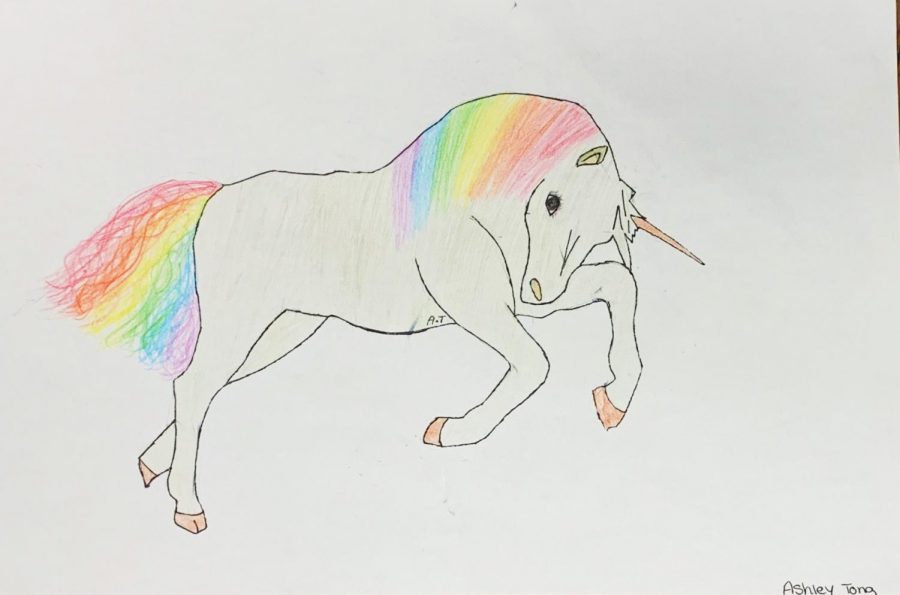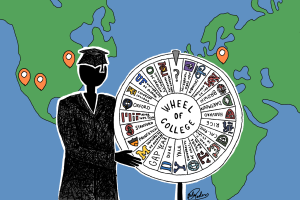Origin of the Modern Unicorn
March 11, 2019
For many centuries, unicorns have inspired people with their enchanting magic and charm. They have thrilled generation after generation and civilization after civilization with their mysterious qualities, their strong yet elegant comportment, and their strange but fantastical appearances. Although there are many interpretations of their appearance, most describe unicorns as a horse with a lion’s tail, a goat’s beard, cloven hooves, and a long horn. These fantastical creatures have experienced a resurgence as of late, with many sparkly, colorful products and food items bringing them to the forefront of pop culture. But the story of the unicorn began a long time ago.
The unicorn has its origins in India around 2700 BCE. Multiple seals that appear to be depicting unicorns have been discovered in Southern Asia, dating back to the Indus Valley Civilization. With their elongated bodies, arched and slender necks, bushy tails, and cloven hooves, the unicorns on these seals are models for the typical unicorn figure. Similar to the role of unicorns in coats of arms, these unicorn seals are thought to be indicators of social status. Seals, often utilized by merchants and traders, were used to identify the merchants and to secure their goods. The symbol of the unicorn was used in daily life by those of a higher social standing, influencing the prestige of the mythological beast for millennia and introducing a regal, solemn quality.
The next culture to recognize the unicorn was that of the Ancient Greeks, who, believing it to be a real creature that hailed from India—a mysterious and fabulous land to them—wrote about them in their natural history instead of their mythology books. Ctesias, the first Ancient Greek to reference the unicorn in his writing in 400 BCE, described the unicorn as a fleet, long-horned, red, white, and black wild ass. Later writers like Aristotle and Strabo continued to describe unicorn-like creatures in their works, but descriptions would vary from horned horses to Indian oxen, which are thought to be rhinoceroses. The name given to the unicorn by the Ancient Greeks, monoceros or cartazonons, literally translates to single horn. This name is thought to originate from karkadann, the Arabic word for rhinoceros.
In the Hebrew Bible, an animal known as the re’em is mentioned. It represents power in the form of a wild and untamable beast of great strength and agility with either one or two horns. Although originally associated with aurochs, a now extinct species of wild cattle, in many translations of the Bible, such as the 1611 King James Version, re’em was translated as unicorn.
The conception of the unicorn in medieval and renaissance times was heavily influenced by both the ancient and biblical understanding and portrayal of the creature. Physiologus, a bestiary written in the 2nd Century AD, popularized the unicorn by presenting an allegory of the Incarnation in which a unicorn is trapped by a maiden when it sees her and lays its head on her lap. Subsequently, the unicorn became very popular, especially in religious depiction. Its association with maidens and virgins added a notion of purity to this strong and wild beast. As humanism became more popular during the Renaissance, the unicorn came to be associated with love and faithful marriage, augmenting its association with purity. This notion of purity, however, came at a cost to the unicorns. Stories that were told by physicians and elites about their horns, which were believed to hold magical properties as they were made of alicorn, caused them to be hunted. People believed the horns could be fashioned into drinking cups to protect against poisoning, powdered or cut into chips for use in cures, or used to purify water. Ancient Greek texts recorded that Indian nobles would drink out of unicorn horns to purify their drinks. In another allegory of the Physiologus, a serpent poisons a water source. The other animals dare not drink it until the unicorn arrives and, drawing a cross with its horn in the water, makes the poison harmless. This story, despite having Indian origins, became a representation of Christ saving others from the poison of the devil.
The unicorn, being such a wild, ferocious beast, became popular in heraldry in the 15th century. Perhaps the most famous use of the unicorn in heraldry is in the royal arms of Scotland. The Scottish, seeing the unicorn as a proud, fierce, uncapturable creature, integrated it into their heraldry since it symbolized many of the things they prized or sought. Unicorns were integrated into many aspects of noble life, from coats of arms of special noblemen to toppers for Mercat Cross pillars. Scotland wasn’t the only country to claim the symbolic powers of the unicorn, however. In Denmark, the Throne Chair of Denmark was claimed to be made entirely from unicorn horns. Although in reality it was made from narwhal tusks, the symbolism provided by unicorn horns proved desirable to the Danish royals.
Today, unicorns are valued for their unique and mystical nature. They have become symbols of hope and joy. In a sort of compounding from previous versions of unicorns, we have taken the aspects we want and need for the climate we live in. Like the Scottish using the unicorn to inspire ferocity in their fight for independence or the Indian nobles hoping to protect themselves from poison, the purity, status, and power of the unicorn make it the perfect mythical beast to inspire us and symbolize our desires and aspirations.







